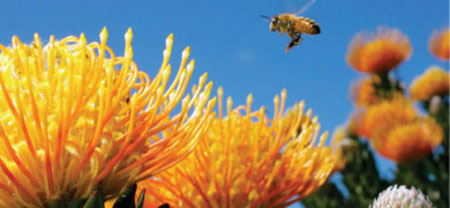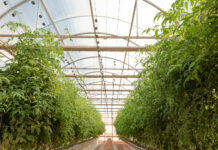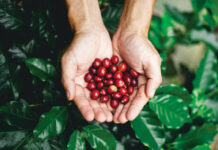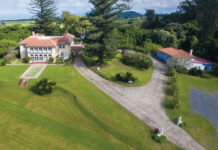Michael Stein
 The Maui Agricultural Research Center (MARC) experiments in fruit-fly control started five years ago with an ingenious trial procedure: a fine mesh was laid in the soil beneath tiny plants of tomato and zucchini to trap pupating larvae under the ground, thus keeping them from the shoots above. As a fail-safe, the station began breeding sterile fruit flies.
The Maui Agricultural Research Center (MARC) experiments in fruit-fly control started five years ago with an ingenious trial procedure: a fine mesh was laid in the soil beneath tiny plants of tomato and zucchini to trap pupating larvae under the ground, thus keeping them from the shoots above. As a fail-safe, the station began breeding sterile fruit flies.
Today the program has progressed to full-scale participation in the Hawai‘i Area Wide Fruit Fly Integrated Pest Management Program (HAW-FLYPM). Environmentally acceptable lures such as para-pheromones—yes, there are fruit-fly perfumes—and food-based attractants are used for sophisticated monitoring of melonfly and Oriental medfly populations. As seasonal changes in the fruit-fly population are detected, MARC can employ suppression techniques more effectively, such as those sterile male flies and parasitoids, which lay their eggs in fruit-fly eggs or larva. Such “integrated pest management programs” achieve a remarkable harmony between agricultural production and environmental safeguards, rejecting wholesale pesticide infusions in favor of increased field sanitation, reduced-risk insecticides, and mass grid-trapping techniques. As David Oka, MARC’s facilities research manager, told me, the center has taught farmers to continue with this control on their own. “We kick-started farmers and hopefully this will continue. It’s a successful program.”
These programs are just a small part of MARC’s experimentation to improve “minor crops,” defined as any commodity crop that grows on fewer than 300,000 acres—which in Hawai‘i means just about any crop except sugar cane. The research stations are an outgrowth of the University of Hawai‘i College of Tropical Agriculture and Human Resources (CTAHR), whose mission is “to actively help Hawai‘i diversify its economy, ensure a sustainable environment and strengthen its communities.” With its three-part goal of instruction, research and practical application in Hawai‘i farmlands, CTAHR is a very special blend of science, education and business that plays an incredibly useful part in preserving Maui’s agriculture.
***
Maui has two CTAHR state research facilities: the Kula station, at 3,000 feet, which conducts trials on cool-climate vegetables and flowers, and the mid-elevation Kula Agriculture Park on Pulehu Road, a County-subsidized park that, according to Oka, is the perfect location for CTAHR to conduct the kind of research on Kula onions, cabbage, tomatoes, and cucumbers that surrounding farmers can use.
Both CTAHR and the stations are the result of farseeing, 19th-century agricultural policy. The federal Morrill Land-Grant Act of 1862 set aside lands on which the states and territories could support agricultural colleges. CTAHR is not only the fruit of that policy, but actually provided the seed for the University of Hawai‘i at Manoa, which began in 1907 as a land-grant
“College of Agriculture and Mechanic Arts.” In 1887, the U.S. Congress passed the Hatch Act, which established agricultural experimental stations at each land-grant college. That the stations have paid back their investment on Maui is an understatement. The fact that tomatoes grow at the Kula Station at all is testimony to the station’s value. For decades Maui tomatoes were threatened with extinction by the spotted wilt virus.
Now the station is striving to breed varieties that will be not only disease-resistant, but, thanks to “back-crossing” (hybridizing) with heirloom tomatoes, differently shaped, more colorful—like the zebra-stripe tomato—and more flavorful as well. At a new, up-to-the-minute biotechnology laboratory on the grounds, genes of hybrid tomatoes are tagged with molecular markers that locate, for example, DNA sequences linked to pest-resistant genes. Such DNA tagging can quickly identify seedlings where the right genes have “taken,” and save months of greenhouse plant propagation.
Similar technology is being used to genetically fingerprint varieties of taro to create a selection of highly diverse plant types, and breed them for resistance to disease pests like phytophthora fungus, which almost wiped out Hana’s taro crop. MARC has also partnered with Hawaiian Commercial & Sugar Company and the United States Department of Agriculture to develop a value-added food product out of taro, says Dr. John Cho, the station’s resident plant pathologist. The product remains tantalizingly secret due to patent applications, but apparently it could be a high-volumed moneymaker for Maui.
Another big economic frontier for taro is its ornamental varieties; their gorgeous violet-banded leaves could make them as trendy as the ornamental cabbage that now flourishes in Mainland city gardens. Such taro plants already grow like perennials in the American southeast. Cho has contacted nurserymen in North Carolina to investigate the possibilities of a market in which each new hybrid could earn up to $1 million in royalties every five years.
The hope is that the station can create a program as successful as its protea-breeding activities, which have helped the Hawai‘i protea industry earn upwards of $2 million in sales. In its terraced protea section, bright with varieties like the torch-shaped king and spidery orange and yellow pincushion, the station has grown close to 300 hybrids. More than 60 varieties have been released to the industry in the past four years. Oka explained that “farmers receive vegetative cuttings from the new hybrids, for which they pay a small fee; that money goes back into research.”
Protea are hybridized to boost disease resistance and exhibit desirable commercial traits like longer and narrower stems (which reduce shipping costs), longer vase life, or simply a delectable variety of colors. Oka shows off one example, where a protea with needlelike leaves and somewhat bland-looking bracts (blossoms) has been crossed with one with wide leaves and bright red bracts to produce a new hybrid with the right leaf size for packing and a beautiful yellow-orange-red banded bloom. A similar effort is now underway to support Maui’s lei flowers, currently being challenged by competition from the Thai orchid lei industry. In a partnership with groups like the Maui Flower Council, CTAHR plans to develop longer-lasting plumeria strains for export.
CTAHR is also helping Hawaiian Homeland farmers break into this potential market. Cho finds it inconceivable that any plant pathologist could perform his job exclusively within the confines of a laboratory. “If you don’t care about farmers themselves,” says Cho, “you won’t last too long.” The college’s extension agents perform educational outreach for farmers, holding workshops on subjects like diseases, marketing, farm management, and, more recently, the HAW-FLYPM fruit-fly-management program.
MARC’s assistance to farmers goes beyond the teaching stage. Specialist Mike Kawate gathers data related to registration requirements for the safe usage of fertilizers, pesticides and other chemicals used on Hawai‘i crops, establishing optimal levels that won’t degrade the environment or water quality. “In one case we had to generate data to keep the Environmental Protection Administration from canceling the use of a pesticide,” explains Kawate. “You could almost say it was saving an industry.”
Another U.H. extension specialist, H.C. “Skip” Bittenbender, is working on Moloka‘i to help resurrect the old Coffees of Hawai‘i farm by adapting a mechanized pruning system. The aim is to shorten and narrow the trees, and coax new growth. Bittenbender hopes the lessons learned on Moloka‘i will help fledgling growers in Kula and Hana; his goal is to assess how different coffee varieties grow in different areas, and “reproduce the world’s finest coffees here in our state.”
The station’s programs have not been immune to budgetary pressures, but Harold Keyser, the county administrator overseeing extension services and research stations in Maui Nui, says they survive through federal and state land-grant formula funds, and line-item project funding from Maui’s Office of Economic Development. The Maui Farm Bureau has also raised money to support the tomato project. Keyser feels confident that future projects will go forward, including an examination of nitrogen transformation through soils.
Then there are the roses. Strangely enough, the Kula station has a Mainland-style rose garden. That’s because it participates in the All-American Gold Medal Roses new varieties program; in the spirit of marketing, this program sends previews for member growers and the general public to admire. The lovely white roses stippled with magenta, or fringed with coronas of pale orange and pink and yellow, are there to whet flower buyers’ appetites, and because, as Oka says, “we get to enjoy the new hybrids a year before they are available to the public. We will be receiving the ’08 varieties any day.”
It seems that for a program that’s almost as necessary to Hawai‘i agriculture as air, water and sunlight, a beautiful bouquet of roses is well deserved.





